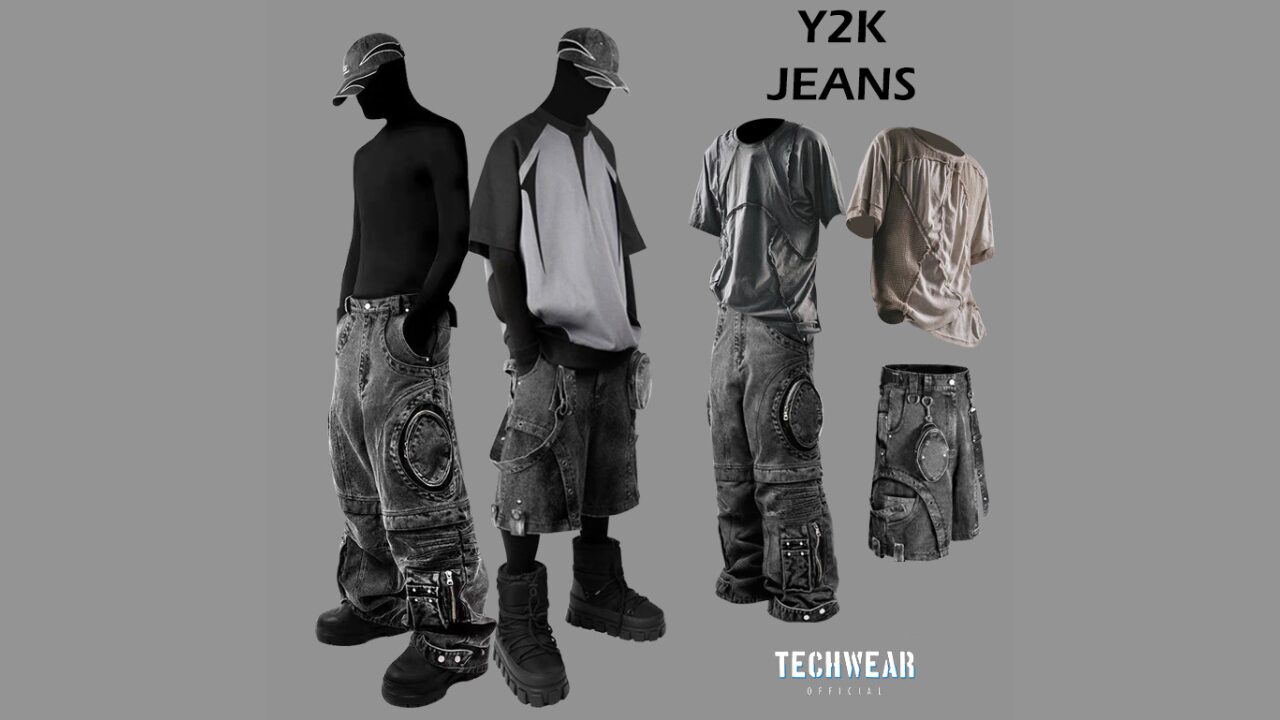Remember trying to figure out someone’s music taste just by looking at them back in the day? In the early 2000s, you totally could. It wasn’t about the headphones they wore; it was about the jeans. Y2K denim wasn’t just clothing. It was a secret handshake, a walking mixtape, a head-to-toe mood board for the music we blasted on our Sony Discmans. The cut, the wash, and even the amount of glitter on the back pockets gave away your entire playlist.
Let’s take a trip back.
The Pop Princess Protocol: Low-Rise, High-Gloss
Close your eyes. Think of the year 2000. You’re probably picturing Britney Spears in a denim outfit so iconic it’s practically a member of *NSYNC. This was the era of the low-rise flare. That hip-grazing, belly-baring cut wasn’t just a style; it was an attitude. It matched the confident, dance-heavy, “I’m not a girl, not yet a woman” energy of pop music perfectly. You couldn’t exactly do the “Oops!” dance in a pair of mom jeans.
And then there was the maximalism. Denim-on-denim everything. Remember Britney and Justin in matching head-to-toe denim at the AMAs? It was a little ridiculous, but we loved it. It was as over-the-top and fun as the music itself. You could see the ultimate high waist vs low rise Y2K jeans comparison play out in every mall, representing two different approaches to the body: one sculpting and elongating, the other exposing and framing. These jeans were also our glittery canvases. Bedazzled butterflies, rhinestone-studded pockets, fancy stitching—our jeans were as produced and polished as the pop stars we idolized. They were costumes for our own everyday music videos, making us feel like we had a little bit of that star power, too.
The Hip-Hop & R&B Swagger: Baggy, Bold, and Built Different
While pop was all about the tight and shiny, hip-hop and R&B were building a different kind of cool. This was the reign of the baggy jean. We’re talking Rocawear, Sean John, FUBU—jeans that felt less like pants and more like a statement. Sagging just so, these jeans were a quiet rebellion. They said, “We’re comfortable, we’re confident, and we play by our own rules.”
The music was all about beats, lyrics, and storytelling, and the jeans reflected that. They weren’t plain; they were walking art projects. Huge logos across the back, intricate patches, patterns that told a story. For the ladies, it was about that powerful, matching denim set. Think Aaliyah in those iconic low-rise cargos and a denim jacket. It was a look that was both tough and beautiful, mirroring the new wave of independent, powerful anthems from Destiny’s Child and others. You felt unstoppable in that outfit, ready to take on the world.
The Pop-Punk & Emo Rebellion: The Skinny Black Uniform
But what if you weren’t feeling the shiny, happy pop or the cool hip-hop swagger? In the basements and at the local Warped Tour, a different uniform was taking hold: the skinny black jean.
This was our rebellion. While everyone else was in light washes and low-rises, we were head-to-toe in black. The skinny jean was androgynous, tight, and almost always ripped—not for fashion, but because they felt real. They perfectly captured the angst, the heartbreak, and the raw energy of bands like My Chemical Romance and Fall Out Boy. The black denim was like a blank slate for our feelings, and the rips were where our souls were supposedly showing. Paired with a well-worn band tee and scuffed-up Converse, it was a uniform that screamed, “We don’t fit in with your mainstream, and we’re proud of it.”

More Than Just a Comeback
It’s no surprise these styles are roaring back. It’s not just about fashion cycling; it’s about the feelings and the music we attach to them. When someone today slips on a pair of low-rise flares, they’re tapping into that unapologetic pop confidence. When they rock oversized cargos, they’re borrowing a little of that hip-hop swagger.
The Y2K denim revival today is more than just nostalgia; it’s a testament to how powerfully these styles were coded to their musical genres. When a Gen Z consumer dons a pair of low-rise flares, they are tapping into the unapologetic confidence of 2000s pop. When they wear oversized, logo-heavy cargos, they are channeling the swagger of early 2000s hip-hop. And the enduring popularity of the skinny jean, even as it cycles in and out of trend, remains forever linked to the emotional resonance of emo.
Y2K jeans were the fabric upon which the aesthetics of a musical era were printed. They were a non-verbal language, telling you the soundtrack of a person’s life before a single note was played. In their stitches, dyes, and silhouettes, they wove together the diverse, chaotic, and unforgettable symphony of the turn of the millennium.

